Google Nexus 4 and Nexus 10 Performance Preview
by Anand Lal Shimpi & Brian Klug on November 2, 2012 11:00 AM ESTGPU Performance
This section is particularly exciting because it's our first look at ARM's new Mali-T604 GPU in our standard mobile 3D performance suite. We've already seen the Nexus 4's Adreno 320 in action, but the Nexus 10's behavior here should be interesting to see.
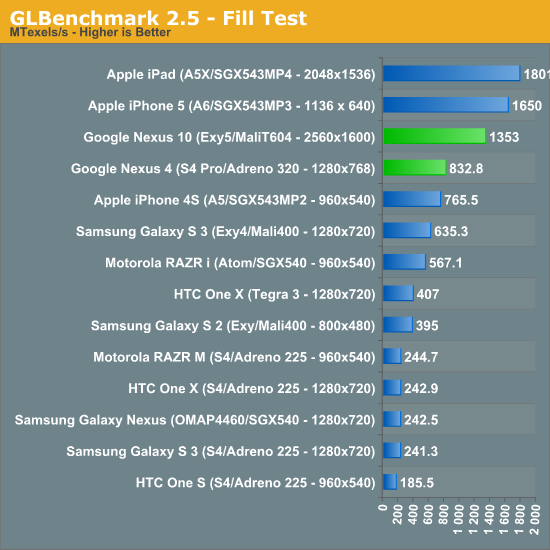
As far as raw fillrates are concerned, both Nexus devices do quite well here at their native resolutions. The iPad and iPhone 5 are both quicker, but we're still good gains over the previous generation of hardware - particularly for the Mali-T604. Compared to the Mali-400MP4 in the Galaxy S 3, we're seeing more than 2x the performance out of ARM's latest GPU.
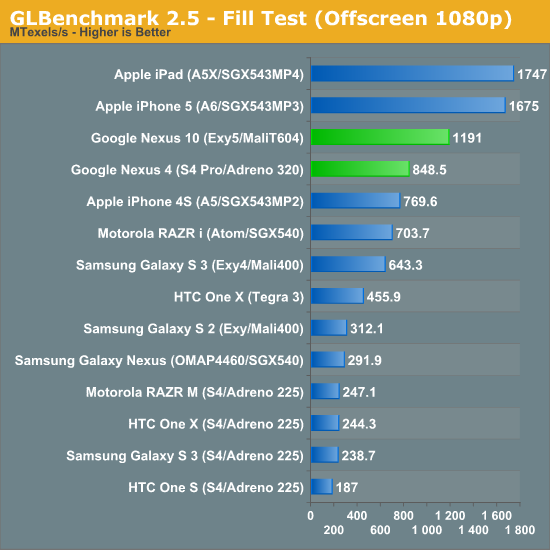
At normalized resolutions the standings don't really change.
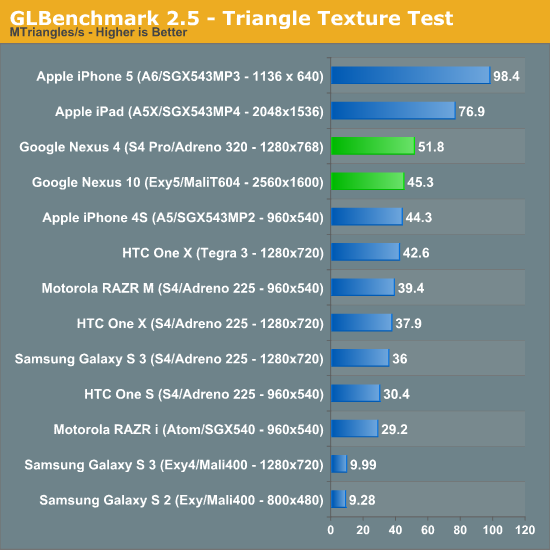
The T604 is ARM's first unified shader architecture, which gives it far more balanced pixel/vertex shader performance. The result is a more than 4x increase in triangle throughput compared to the Mali 400MP4. It's not enough to give the Nexus 10 the edge over the latest Apple devices, but it's a huge improvement over where ARM was in the previous generation. The Adreno 320 continues to be quite strong here as well.
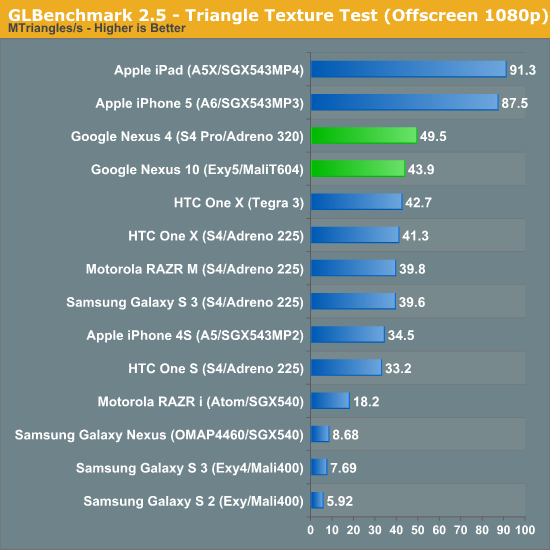
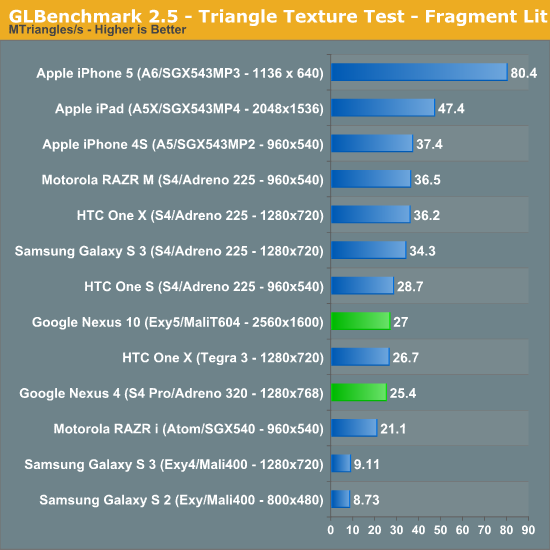
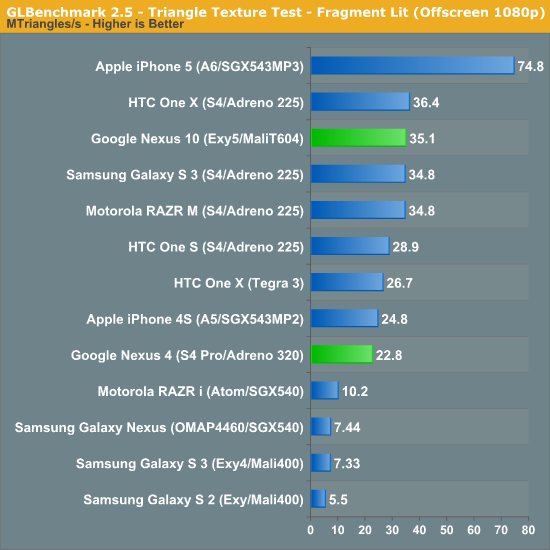
Once again we're seeing huge gains for the Mali-T604 compared to the Mali-400MP4. The Adreno 320 in the Nexus 4 actually performs worse than the Adreno 225 in older devices, possibly due to thermal throttling we saw on the Nexus 4 sample during periods of heavy load.
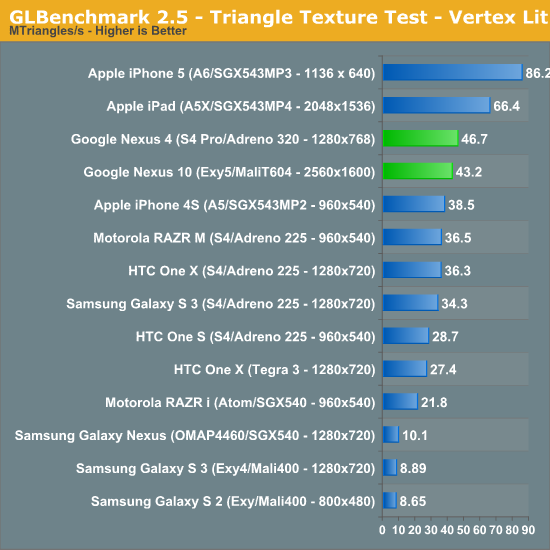
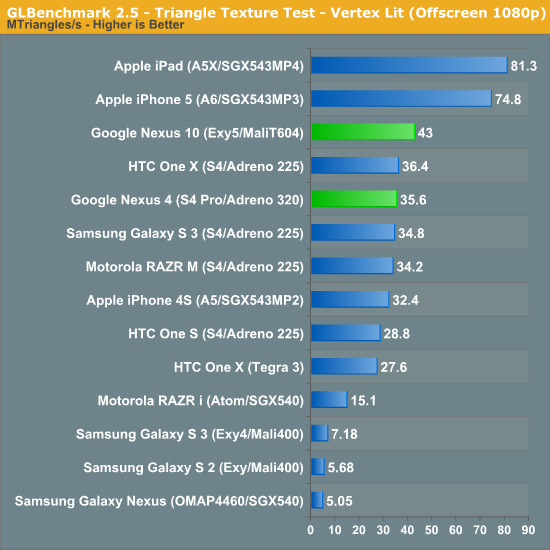
ARM shows the biggest gains here once again thanks to its move to a unified shader architecture. The Adreno 320 does ok here but it's really no better than the 225, I suspect there is some thermal throttling happening on the device.
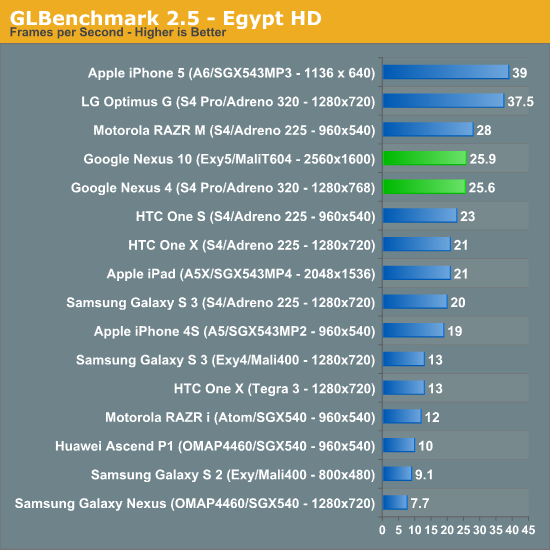
At native resolutions, the Nexus 10 and NExus 4 are both capable of putting out decent frame rates in Egypt HD. What this data tells us is they'll likely be able to run current and even some future titles, at native res, at 30 fps without much of an issue.
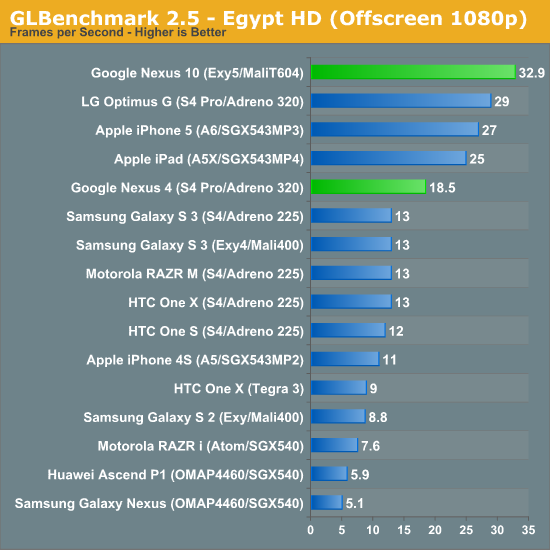
Normalize resolution and the Mali-T604 actually does very well here, setting a new performance record. Despite being based on the same hardware, the Optimus G is able to post a much higher score here than the Nexus 4. The explanation is simple: the Optimus G can't complete a single, continuous run of GLBenchmark 2.5 - the app will run out of texture memory and crash if you try to run through the entire suite in a single setting. The outcome is that the Optimus G avoids some otherwise nasty throttling. The Nexus 4 on the other hand manages to complete everything, but likely quickly throttles its clocks down due to thermal constraints. The Nexus 4 was really hot by the end of our GLBenchmark run, which does point to some thermal throttling going on here. I do wonder if the Snapdragon S4 Pro is a bit too much for a smartphone, and is better suited for a tablet at 28nm.
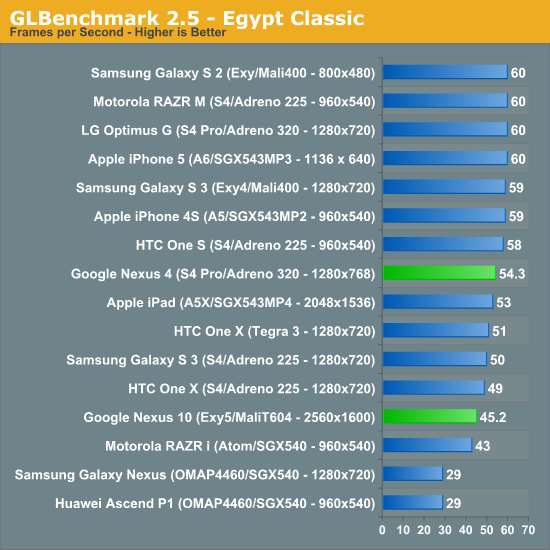
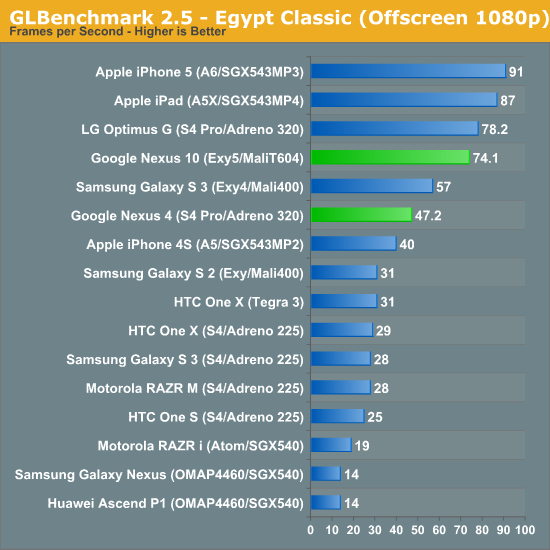
The Egypt Classic numbers are less interesting, but both platforms do well here.
Battery Life
We didn't have time to run through our entire battery life suite, but we do have some relevant results for the two devices. For smartphones, these are our latest web browsing battery life tests:
We regularly load web pages at a fixed interval until the battery dies (all displays are calibrated to 200 nits as always). The differences between this test and our previous one boil down to the amount of network activity and CPU load.
On the network side, we've done a lot more to prevent aggressive browser caching of our web pages. Some caching is important otherwise you end up with a baseband test, but it's clear what we had previously wasn't working. Brian made sure that despite the increased network load, the baseband still had the opportunity to enter its idle state during the course of the benchmark.
We also increased CPU workload along two vectors: we decreased pause time between web page loads and we shifted to full desktop web pages, some of which are very js heavy. The end result is a CPU usage profile that mimics constant, heavy usage beyond just web browsing. Everything you do on your smartphone ends up causing CPU usage peaks - opening applications, navigating around the OS and of course using apps themselves. Our 5th generation web browsing battery life test should map well to more types of smartphone usage, not just idle content consumption of data from web pages.
As always we test across multiple air interfaces (3G, 4G LTE, WiFi), but due to the increased network load we actually find that on a given process technology we see an increase in battery life on faster network connections. The why is quite simple to understand: the faster a page is able to fully render, the quicker all components can drive down to their idle power states.
All Android tests use Chrome and 5GHz WiFi unless otherwise listed.
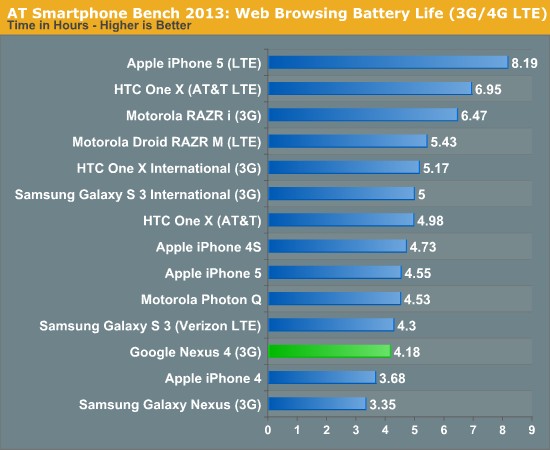
The Nexus 4 doesn't break any records for 3G battery life, it ends up relatively low on our list - even the Galaxy S 3 manages to do better here on 3G.

WiFi battery life is similar to the Galaxy S 3, but again it's not all that impressive compared to some of the other devices in this list.
Our tablet web browsing battery life test isn't directly comparable to the new smartphone tests, so we've got a separate chart for the Nexus 10:
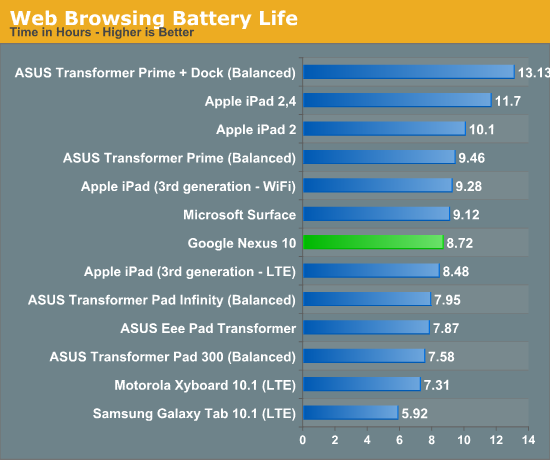
Despite driving a very high res panel, Google is able to deliver relatively competitive battery life with the Nexus 10. Battery capacity is around 80% the size of the 3rd gen iPad and battery life is around 93% of what Apple delivers here. Over 10 hours would be nice to have, but 8 hours of use in this test isn't bad at all. We'll have to do more testing to understand Exynos 5's power behavior a bit better, but so far it doesn't seem that the platform is all that bad from a power consumption standpoint. It remains to be seen how gracefully the Nexus 10 will handle being taxed heavier.
Display
We're still running our big display analysis routines on the new Nexus devices, but the brightness/contrast data below is a little teaser:
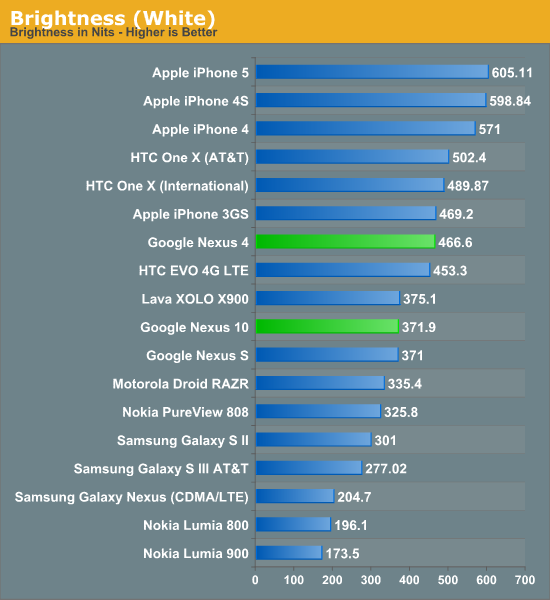
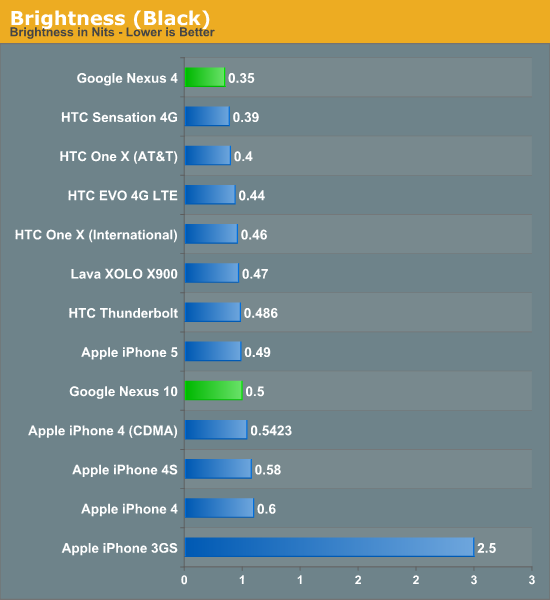
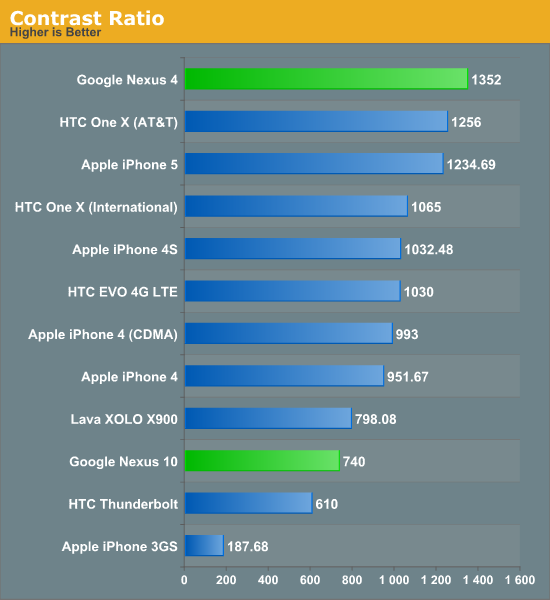
Final Words
We still have a lot of additional writing and testing ahead of us. Stay tuned for our full review of both devices!










244 Comments
View All Comments
BlueScreenJunky - Saturday, November 3, 2012 - link
Clearly 2560*1600 is useless, and I'd have preferred a 1920*1200 panel (or actually I don't care, I think I'm not buying the N10 after all), but if I recall correctly it was Apple who started the trend of "more pixel density is better" with their "retina" display.It's kinda funny to see how when I said I preferred an AMOLED display to a 'retina' LCD apple users answered that retina was better because it had more pixels, and now that the Nexus 10 has even more it's useless XD
(Exactly in the same way that Android fanboys used to say the iPhone was rubbish because the Nexus One had an SD card slot and removable battery, and since the Nexus S they don't care about Sd cards anymore ;-) )
Johnmcl7 - Saturday, November 3, 2012 - link
I'm not an Android fanboy but I have been disappointed with the Nexus devices both dropping micro SD slots hence my current phone is a Note and I'm pleased to see Samsung still offering removable batteries and micro SD expansion..John
TekDemon - Tuesday, November 13, 2012 - link
I wouldn't mind it too much if they had offered higher storage amounts with the phones! There have been a lot of issues with SD storage on android so I can see why they basically decided to dump it for the nexus line.doobydoo - Monday, November 5, 2012 - link
'It's kinda funny to see how when I said I preferred an AMOLED display to a 'retina' LCD apple users answered that retina was better because it had more pixels, and now that the Nexus 10 has even more it's useless XD'Just to clarify, this can logically make sense.
The AMOLED displays you preferred was seen as 'not as good' because it had a lower resolution and said lower resolution was visible.
Adding more pixels than the iPad, depending on your eyesight, can arguably add little to no value if the end user isn't able to tell the difference.
In other words, there is a point beyond which adding more pixels adds little benefit, that doesn't mean that it applies from any starting point.
UltraTech79 - Friday, November 2, 2012 - link
As someone that doesnt buy Apple products and sticks more to Google, and I think I speak for a lot of people here; SHUT THE FUCK UP. Youre a fucking moron. Take your petty little boy bullshit and go to another website. This place is for adults.gorash - Saturday, November 3, 2012 - link
Overreating much.baozebub - Saturday, November 3, 2012 - link
Well said. Out of respect for the quality of anandtech analysis, we should shout down any flame wars from any side.Calista - Sunday, November 4, 2012 - link
Well spoken!darwinosx - Saturday, November 17, 2012 - link
Are you 12?The only way Google can get people to buy Android tablets is to sell them at cost. How pathetic is that?
TekDemon - Tuesday, November 13, 2012 - link
The iPad 4 has a much beefier GPU that's about twice as powerful as the A5X's. It's too bad it wasn't available yet for benching since it'd have really been a big contrast.